Horned Viper
Cerastes cerastes
Horned vipers sidewind across the desert sands of their home.
Advertisement
Horned Viper Scientific Classification
- Kingdom
- Animalia
- Phylum
- Chordata
- Class
- Reptilia
- Order
- Squamata
- Family
- Viperidae
- Genus
- Vipera
- Scientific Name
- Cerastes cerastes
Read our Complete Guide to Classification of Animals.
Horned Viper Conservation Status
Horned Viper Facts
- Prey
- Rodents, lizards, birds
- Main Prey
- Lizards
- Fun Fact
- Horned vipers sidewind across the desert sands of their home.
- Other Name(s)
- Horned sand viper, desert horned viper
View all of the Horned Viper images!
When Cleopatra committed suicide in 31 B.C. it’s theorized she used this type of snake to end her life.
The horned viper is also known as the horned sand viper and the desert horned viper. The term “horned” is applied because of the scales above the eyes and nose. The features help protect the eyes from sand.
The snake has a unique locomotive nature. It’s a sidewinder, which means it travels in a sideways manner. If threatened, the reptile emits a rattling sound. It’s the first line of defense as the viper cannot hiss.
Like all vipers, the snake’s bite can be dangerous. Its venom effects include, among other things, creating blood clots and straining the heart. In rare cases, humans have ended up as fatalities resulting from this snake’s venom.
What follows is a comprehensive look at these snakes, their identification features, their habitat, prey, and more.
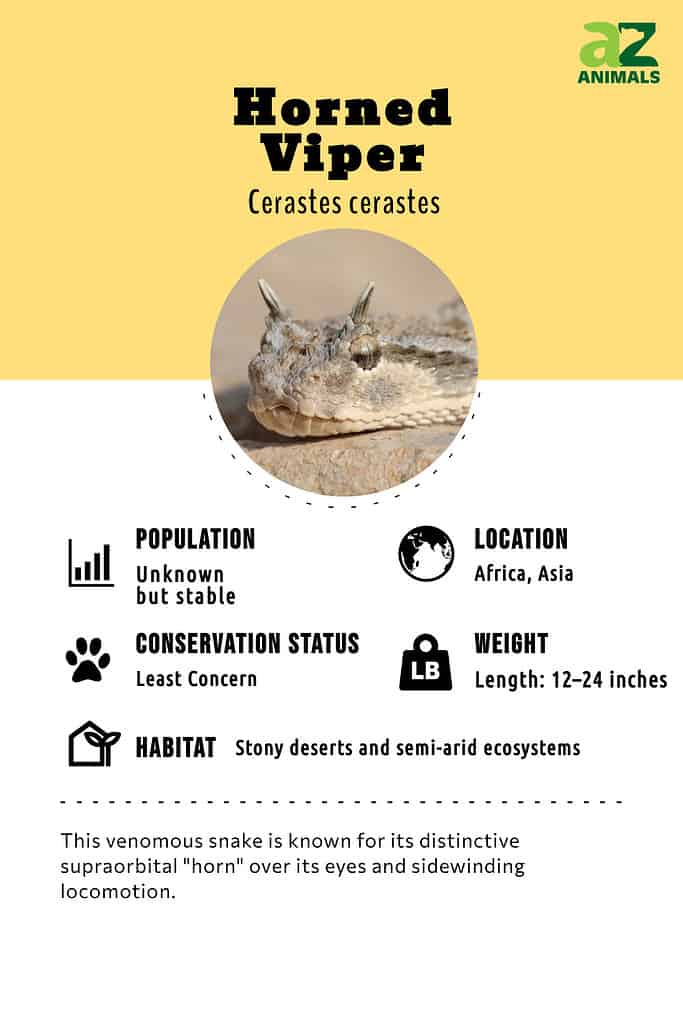
6 Incredible Horned Viper Facts!
- When Cleopatra committed suicide in 31 B.C. it’s theorized she used this type of snake to end her life.
- In Egyptian hieroglyphs, the horned viper is a symbol that represents the phonic alphabet sound of “f.”
- This snake fills its scales with morning dew and uses the reserves as a water resource.
- The spider-tailed horn viper resembles the horned viper but has a distinct identification bulb-like tail that’s more arachnid than anything.
- The snake’s diet is instrumental in controlling the rodent population.
- Archaeologists have found mummies of sand vipers on the Nile banks.
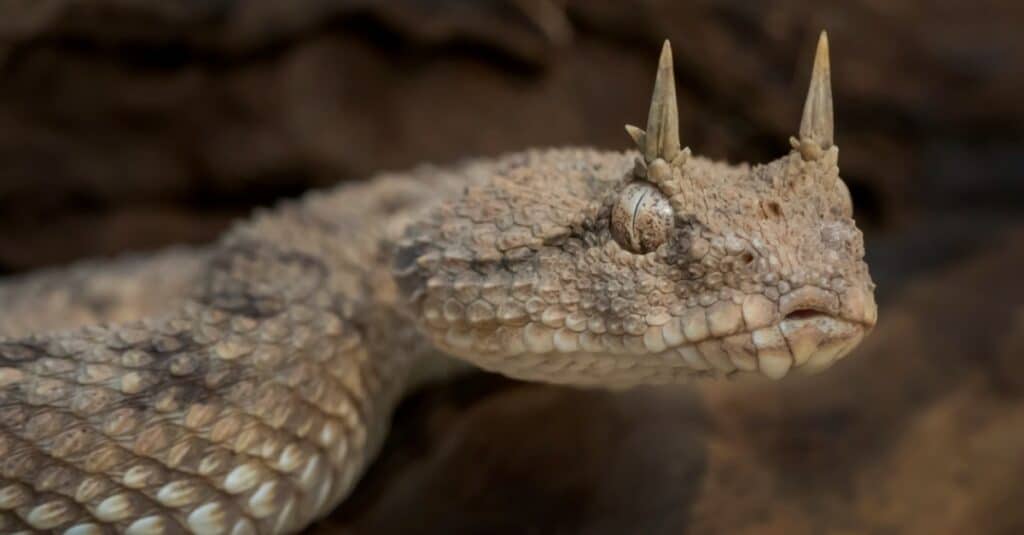
It’s believed Cleopatra used a horned viper to end her life in ancient Egyptian times.
©iStock.com/Mark Kostich
Scientific Name
The horned viper’s scientific name is Cerastes cerastes.
It is a member of the Cerastes genus, of which the common or Sahara sand viper (Cerastes vipera) is also a member. Both are usually referred to as simply sand vipers and are relatively small, growing to only about two feet.
Often, the horned viper’s common name gets applied to completely unrelated species. This includes the horned puff adder (Bitis caudalis) and the sand viper (Vipera ammodytes).
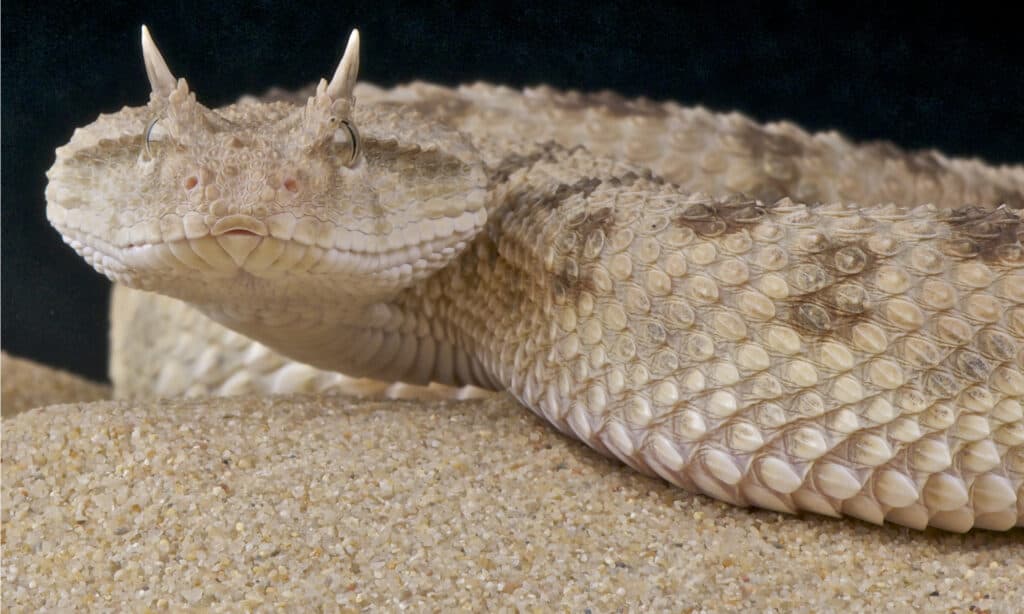
The scientific name of the horned viper is
Cerastes cerastes.
©reptiles4all/Shutterstock.com
3 Types of Horned Vipers
There are three subspecies of horned viper:
- Cerastes cerastes hoofieni
- Cerastes cerastes karlhartli, Egyptian horned viper
- Cerastes cerastes mutila, Algerian horned viper.
C. cerastes hoofieni gets its name from Jacob Haim Hoofien, who studied Middle Eastern herpetology.
Evolution and Origins
The oldest fossil of true, hind leg-less snakes is Hassiophis terasanctus, which dates back between 112 million and 94 million years ago.
The horned viper belongs to the Viperidae family of vipers, which first appeared during the Miocene period.
It evolved to adapt to its desert environment in several ways. There are a few theories as to the reason why the horned viper’s evolution included the development of horns. One is that the horns protect their eyes from sand, which builds up above the eyes instead. Another is that the presence of the horns makes it more difficult for predators to identify them as snakes due to the unusual outline of their heads.
An adaptation that assists the horned viper in its desert habitat is its sidewinding locomotion, which is also used by snake species such as the sidewinder rattlesnake (Crotalus cerastes) and the Namib desert sidewinding adder (Bitis peringueyi). This allows it to travel in a sideways manner across the desert sands and more easily ascend slopes without slipping.
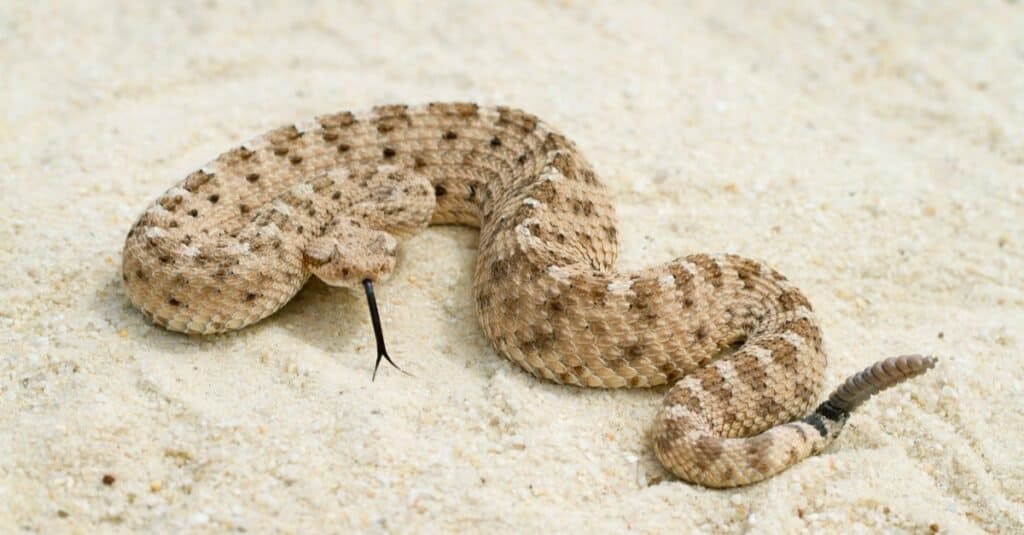
The horned viper uses sidewinding to travel across desert sands, like the sidewinder rattlesnake, above.
©Mark_Kostich/Shutterstock.com
Appearance
While vipers can reach up to 33 inches, their average size is between 12 and 24 inches. These snakes have a robust frame with a thick mid-body, tapering tail, and a narrow neck. Females have smaller heads and eyes and tend to be larger in size.
How to Identify a Horned Viper
- The most distinctive identification, of course, is the supraorbital “horn” over the eyes.
- Horns can be smaller in size or there may none at all.
- Scales protect the viper’s eyes from eyes and help with camouflage.
- Colors vary and include yellowish, brownish, reddish, and grayish shades.
- Colors usually match the soil of snake habitats.
- Blotches can fuse into crossbars.
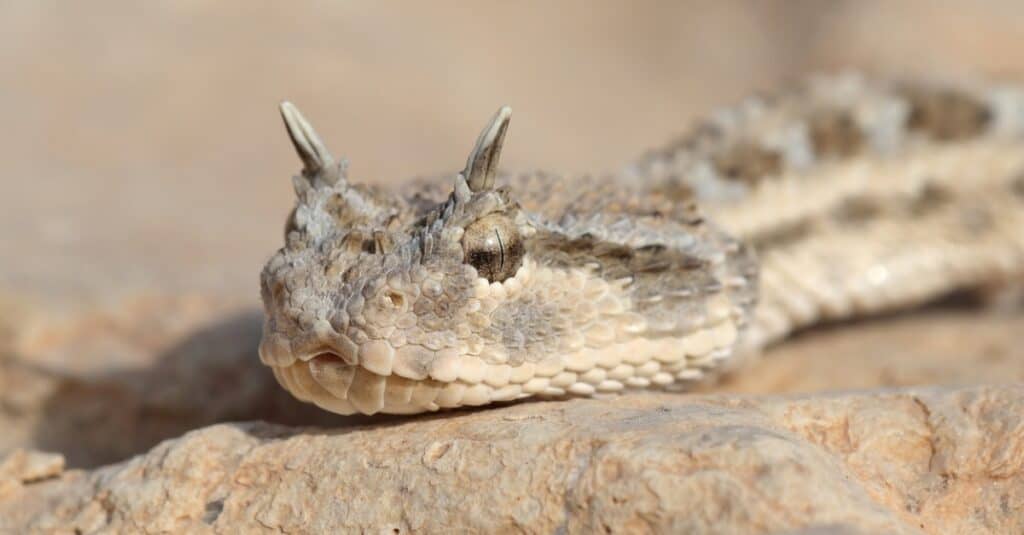
The horns over the eyes are the most distinctive feature of the horned viper.
©iStock.com/bogdanhoria
Habitat
This venomous reptile is native to the Middle East and North Africa, inhabiting stony deserts and semi-arid ecosystems. Primarily snaking along locations in the Middle East and North African deserts, this snake is typically distributed across southwestern Israel and southwestern Arabia. It also frequents the Sahara Desert. The range goes southward to Mali, Niger, Sudan, Chad, and Mauritania.
The reptile prefers sandy deserts and rocky hills. They like wadis, a ravine, valley, or channel that is extremely dry outside of the region’s rainy season.
Records are rare, but there are reports of the reptile in a region of the Sahara called the Sahel. You may find them in dunes and, on the rare occasion, on grave plains and rock pavements. The horned viper, though a solitary creature, has among its adaptations coexisting with the Arabian horned viper in eastern Sinai.

The horned viper inhabits regions of the Sahara Desert.
©MrLis/Shutterstock.com
Behavior
While humans do keep these snakes as pets, it’s wisely advised we keep our distance. The creatures are predators and unpredictable. They are of the wild and aren’t meant to be a captive species. Capable of living in harsh conditions, their adaptations do not include enclosures and handling.
The typical lifespan of the horned viper is between 14 and 18 years.
Venom: How Dangerous Are They?
The venom of this snake isn’t as toxic as other snakes but there has been the rare fatality from a bite. The toxicity is also influenced by the location. The horned viper works with hinged hollow fangs. They unfold into a bite position as the reptile’s mouth opens. That allows the animal to effectively deliver its venom.
The venom has 13 toxins and the composition varies by location and the viper’s range. One powerful blend quickly results in hemorrhagic aftereffects.
Bites can cause the following:
- Massive local swelling
- Excessive clotting or bleeding
- Acute pain
- Nausea
- Necrosis
- Profuse sweating
- Abdominal pain
- Vomiting
- Exhaustion
- Kidney failure
- Hematuria
- Irregularities in the heart.
The venom’s yield is in a range of 20 to 100 milligrams of dried venom. A dose of 40 to 50 mg is a lethal risk for humans.
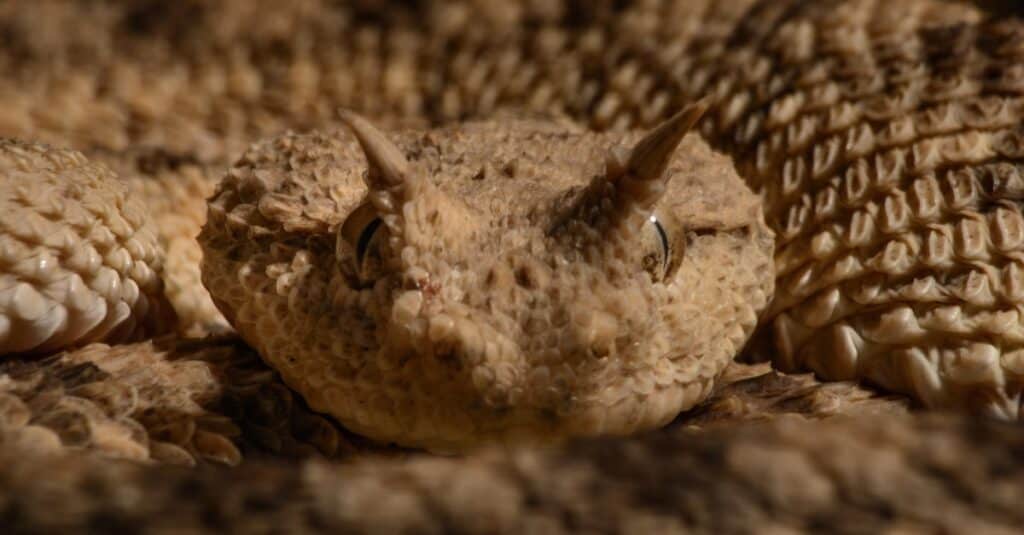
The color of the horned viper generally matches its habitat.
©iStock.com/rippinlines
Diet
This snake primarily feeds on lizards but also takes the occasional mammal (like rodents) or birds.
Horned vipers are ambush predators. The creatures hide in the sand near rocks or under vegetation. When prey comes along, the reptiles strike with scary speed, taking a bite and holding it while the venom effects take place.
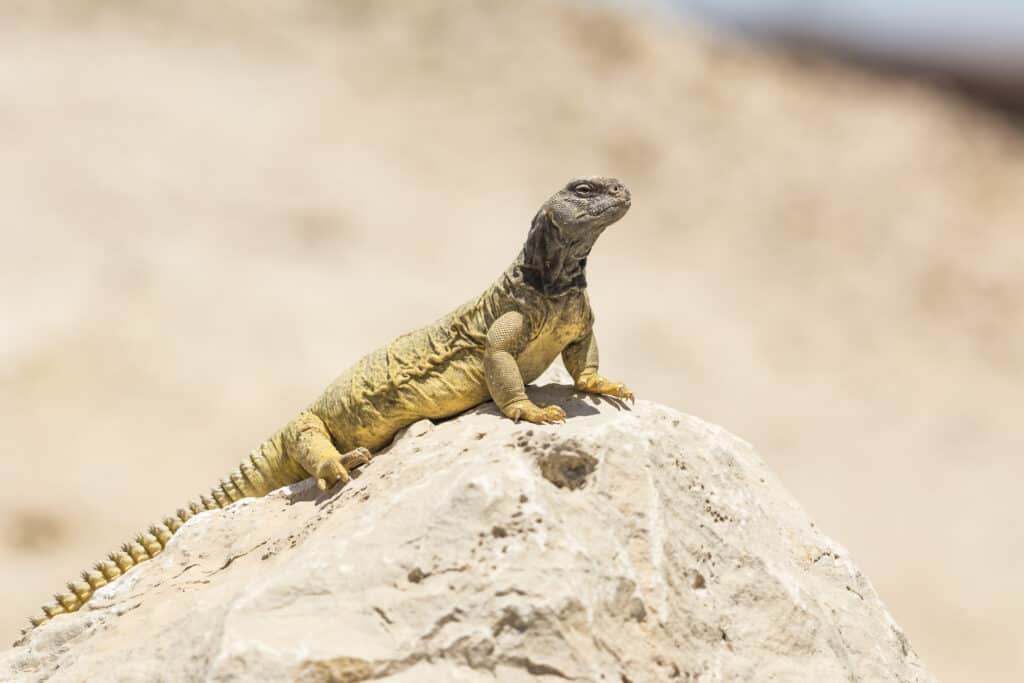
Lizards form part of the horned viper’s diet.
©P.V.R.M/Shutterstock.com
Predators and Threats
The horned viper’s predators include honey badgers, Nile monitors, and feral cats. When threatened, the viper curls and produces rasping sounds by rubbing its keeled scales together.
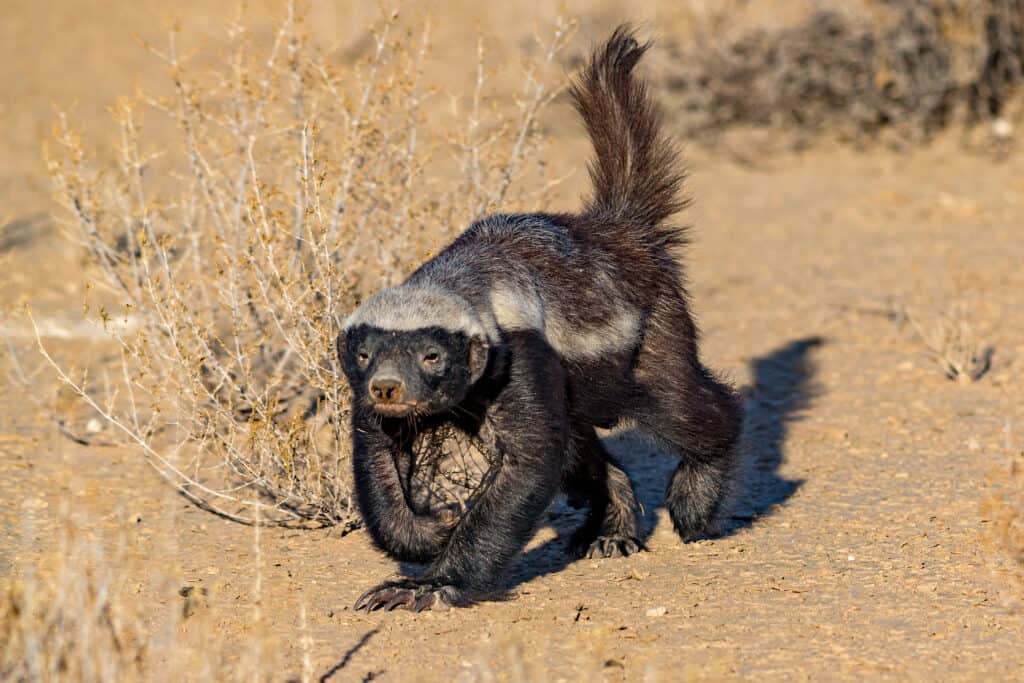
The
honey badger
is one of the horned viper’s predators.
©Braam Collins/Shutterstock.com
Population and Conservation Status
The IUCN has assessed the horned viper as of Least Concern. The species isn’t considered at risk, especially as its adaptations include inhabiting and surviving some of the plant’s harshest ecosystems. Its population numbers are unknown but remain stable.
Like many reptiles, over-collection (in this case, for venom extraction), habitat destruction, and the introduction of invasive species into the population are harming the horned viper.
Similar Animals
- Spider tailed horned vipers don’t have true horns, but it looks pretty similar!
- Saw-scaled vipers are one of the big four in India.
- A Russel’s viper is small but its venom is mighty.
Horned Viper FAQs (Frequently Asked Questions)
Is a horned viper venomous?
Yes. The facts are all vipers are toxic and poisonous. The impact of the bite can vary, going from pain to blood clotting and even to death.
What eats a horned viper?
Predators of the horned viper include honey badgers, Nile monitors and various feral wild cats. When threatened, the viper curls and produces rasping sounds by rubbing its keeled scales together.
Why does the horned viper have horns?
The horns protect the eyes from the harsh conditions of its environment, especially blown sand.
What does the horned viper eat?
The horned viper’s diet comes from creatures that also survive in arid conditions. That includes pretty much any lizard it can find. The reptile also enjoys small desert mammals and birds that might slip into its hunting grounds.
How venomous is a horned viper?
Venom effects from a horned viper bite can be serious. Human victims have seen a range of harm, including the development of extensive swelling and systemic envenoming (spontaneous bleeding, hypovolaemic shock, neurotoxicity, muscle damage, incoagulable blood).
What is a spider-tailed horned viper?
The spider-tailed horned viper is of the P. urarachnoides species and is local to western Iran. It has a tail that resembles a spider and uses the appendage to lure prey in. The spider-tailed viper comes in mostly muted colors that make hiding easy.
What is the lifespan of a horned viper?
The typical lifespan of the horned viper is between 14 and 18 years.
What are some other horned snakes?
There are a number of snakes with horns from across the world. Other examples include the horned puff adder, West African gaboon viper, leaf-nosed snake, and sidewinder rattlesnake.
Thank you for reading! Have some feedback for us? Contact the AZ Animals editorial team.
Sources
- the reptile database, Available here: https://reptile-database.reptarium.cz/species?genus=Cerastes&species=cerastes
- DesertUSA, Available here: https://www.desertusa.com/animals/horned_viper.html
- Basel Zoo, Available here: https://www.zoobasel.ch/en/tiere/tierlexikon/tierbeschreibung/437/hornviper/
- kidadl, Available here: https://kidadl.com/animal-facts/horned-viper-facts
- Animal Diversity Web, Available here: https://animaldiversity.org/accounts/Cerastes_cerastes/#:~:text=Found%20throughout%20the%20Sahara%20in,rock%20pavement%20and%20gravel%20plains.
- Snake Facts, Available here: https://snake-facts.weebly.com/horned-viper.html
- Science Focus, Available here: https://www.sciencefocus.com/nature/spider-tailed-horned-viper/

















